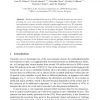Free Online Productivity Tools
i2Speak
i2Symbol
i2OCR
iTex2Img
iWeb2Print
iWeb2Shot
i2Type
iPdf2Split
iPdf2Merge
i2Bopomofo
i2Arabic
i2Style
i2Image
i2PDF
iLatex2Rtf
Sci2ools
PATMOS
2005
Springer
2005
Springer
Energy Characterization of Garbage Collectors for Dynamic Applications on Embedded Systems
Abstract. Modern embedded devices (e.g. PDAs, mobile phones) are now incorporating Java as a very popular implementation language in their designs. These new embedded systems include multiple complex applications (e.g. 3D rendering applications) that are dynamically launched by the user, which can produce very energy-hungry systems if they are not properly designed. Therefore, it is crucial for new embedded devices a better understanding of the interactions between the applications and the garbage collectors to reduce their energy consumption and to extend their battery life. In this paper we present a complete study, from an energy viewpoint, of the different state-of-the-art garbage collectors mechanisms (e.g. mark-and-sweep, generational garbage collectors) for embedded systems. Our results show that traditional solutions of garbage collectors for Java-based systems do not seem to produce the lowest energy consumption solutions.
| Added | 28 Jun 2010 |
| Updated | 28 Jun 2010 |
| Type | Conference |
| Year | 2005 |
| Where | PATMOS |
| Authors | José Manuel Velasco, David Atienza, Katzalin Olcoz, Francky Catthoor, Francisco Tirado, Jose Manuel Mendias |
Comments (0)

